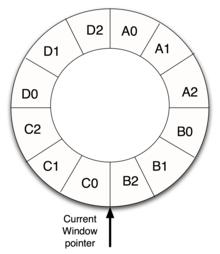This article has multiple issues. Please help improve it or discuss these issues on the talk page. (Learn how and when to remove these template messages)
|
In computer engineering, register windows are a feature which dedicates registers to a subroutine by dynamically aliasing a subset of internal registers to fixed, programmer-visible registers. Register windows are implemented to improve the performance of a processor by reducing the number of stack operations required for function calls and returns. One of the most influential features of the Berkeley RISC design, they were later implemented in instruction set architectures such as AMD Am29000, Intel i960, Sun Microsystems SPARC, and Intel Itanium.

General Operation edit
Several sets of registers are provided for the different parts of the program. Registers are deliberately hidden from the programmer to force several subroutines to share processor resources.
Rendering the registers invisible can be implemented efficiently; the CPU recognizes the movement from one part of the program to another during a procedure call. It is accomplished by one of a small number of instructions (prologue) and ends with one of a similarly small set (epilogue). In the Berkeley design, these calls would cause a new set of registers to be "swapped in" at that point, or marked as "dead" (or "reusable") when the call ends.
Application in CPUs edit
In the Berkeley RISC design, only eight registers out of a total of 64 are visible to the programs. The complete set of registers are known as the register file, and any particular set of eight as a window. The file allows up to eight procedure calls to have their own register sets. As long as the program does not call down chains longer than eight calls deep, the registers never have to be spilled, i.e. saved out to main memory or cache which is a slow process compared to register access.
By comparison, the Sun Microsystems SPARC architecture provides simultaneous visibility into four sets of eight registers each. Three sets of eight registers each are "windowed". Eight registers (i0 through i7) form the input registers to the current procedure level. Eight registers (L0 through L7) are local to the current procedure level, and eight registers (o0 through o7) are the outputs from the current procedure level to the next level called. When a procedure is called, the register window shifts by sixteen registers, hiding the old input registers and old local registers and making the old output registers the new input registers. The common registers (old output registers and new input registers) are used for parameter passing. Finally, eight registers (g0 through g7) are globally visible to all procedure levels.
The AMD 29000 improved the design by allowing the windows to be of variable size, which helps utilization in the common case where fewer than eight registers are needed for a call. It also separated the registers into a global set of 64, and an additional 128 for the windows. Similarly, the IA-64 (Itanium) architecture used variable-sized windows, with 32 global registers and 96 for the windows.
In the Infineon C166 architecture, most registers are simply locations in internal RAM which have the additional property of being accessible as registers. Of these, the addresses of the 16 general-purpose registers (R0-R15) are not fixed. Instead, the R0 register is located at the address pointed to by the "Context Pointer" (CP) register, and the remaining 15 registers follow sequentially thereafter.[1]
Register windows also provide an easy upgrade path. Since the additional registers are invisible to the programs, additional windows can be added at any time. For instance, the use of object-oriented programming often results in a greater number of "smaller" calls, which can be accommodated by increasing the windows from eight to sixteen for instance. This was the approach used in the SPARC, which has included more register windows with newer generations of the architecture. The end result is fewer slow register window spill and fill operations because the register windows overflow less often.
Criticism edit
Register windows are not the only way to improve register performance. The group at Stanford University designing the MIPS saw the Berkeley work and decided that the problem was not a shortage of registers, but poor utilization of the existing ones. They instead invested more time in their compiler's register allocation, making sure it wisely used the larger set available in MIPS. This resulted in reduced complexity of the chip, with one half the total number of registers, while offering potentially higher performance in those cases where a single procedure could make use of the larger visible register space. In the end, with modern compilers, MIPS makes better use of its register space even during procedure calls.[citation needed]
References edit
- ^ "Infineon C166 Family Instruction Set Manual" (PDF). Keil. Retrieved 2020-03-12.
- Frantzen, Mike; Shuey, Mike (2001). "StackGhost: Hardware Facilitated Stack Protection". Proceedings of the 10th Usenix Security Symposium. USENIX. pp. 55–66. Retrieved 27 August 2010.
- Magnusson, Peter (April 1997). "Understanding stacks and registers in the Sparc architecture(s)". Archived from the original on 24 December 2012. Retrieved 27 August 2010.
- Mueller, Frank. "setjmp/longjmp". Discussing the complex Sparc implementation due to windowing.